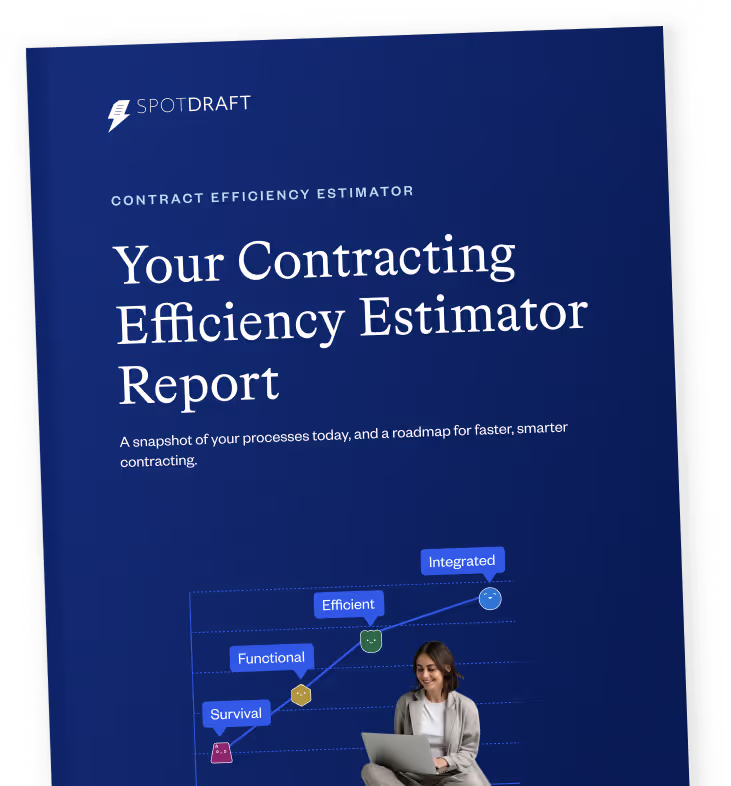Key Takeaways
- Contract analytics transforms legal from reactive to proactive. It enables legal teams to identify risks and compliance gaps before they escalate.
- AI-driven insights turn static contracts into live data sources. By analyzing patterns in clauses, renewals, and counterparties, legal can predict potential risk scenarios early.
- Better data means better decisions. Predictive analytics supports evidence-based negotiation, faster risk mitigation, and improved governance.
- Efficiency doesn’t mean compromise. Analytics automates repetitive review tasks so lawyers can focus on strategy and complex risk assessments.
- The future is predictive and connected. Integrating analytics across systems, such as CLM, CRM, and ERP, builds a real-time, organization-wide risk intelligence ecosystem
Introduction
Modern in-house legal teams are under growing pressure to prevent risks before they escalate, not just react after the damage is done. Deal cycles are faster, compliance expectations are stricter, and the cost of oversight failures is higher than ever. Yet most legal departments still rely on static spreadsheets or manual reviews that only reveal what’s already gone wrong.
That reactive approach leaves legal constantly firefighting; chasing missed renewals, uncovering risky clauses too late, or discovering non-compliance only after an audit. The result is lost time, avoidable exposure, and frustrated business partners.
Across industries, legal teams are rapidly adopting contract management tools, but adoption doesn’t always equal optimization. 68% of contract professionals say they search for completed contracts at least once a week, highlighting how much valuable information remains buried in static repositories.
This is where contract analytics comes in, transforming contracts from static documents into live data sources that reveal risks before they strike. Imagine knowing which vendor contracts are most likely to miss renewal deadlines or which customer clauses often trigger disputes weeks before they happen.
That’s what proactive risk prediction through contract analytics enables.
What is Contract Analytics?
Contract analytics is the process of using technology, including artificial intelligence (AI), natural language processing (NLP), and machine learning (ML), to extract, classify, and interpret contract data at scale. It goes far beyond simple keyword searches or manual clause reviews. With contract analytics, legal teams can automatically identify key clauses, obligations, and risk indicators that are often buried across thousands of agreements.
For example, analytics can review 5,000 contracts and instantly flag all agreements with indemnity clauses above a certain threshold or termination triggers within 30 days. Instead of combing through PDFs or spreadsheets, legal professionals get structured, searchable insights that surface risk before it becomes a problem.
According to Co-Founder & CEO of SpotDraft, Shashank Bijapur,
AI is not going to take away jobs of lawyers, but somebody—a lawyer with AI—is definitely going to take away your job. Knowing how to leverage AI to do what lawyers do on an ongoing basis is very important and essential.
Contract analytics can operate on multiple levels:
- Descriptive – What happened?
- Diagnostic – Why did it happen?
- Predictive – What may happen next?
- Prescriptive – What action should we take?
In short, think of contract analytics as your legal team’s early warning system, powered by data. It transforms static contracts into dynamic sources of business intelligence and proactive risk management.
The Traditional Approach: Where Risk Management Falls Short
For most legal teams, risk management has traditionally been reactive. Issues are tracked only after they occur. Contract breaches are investigated post-escalation, disputes are handled once they’ve already strained relationships, and renewal data is chased days before key deadlines. By the time a potential risk is discovered, it has often already turned into a real one.
The problem lies in where this information lives: across disconnected silos. Critical data is buried in PDFs, hidden in email attachments, or trapped in outdated contract versions spread across departments. Manual audits and spreadsheet tracking are slow, inconsistent, and incomplete. The result is a cycle of firefighting, where lawyers spend hours resolving problems instead of preventing them.
This backward-looking model makes it difficult for legal teams to provide meaningful foresight or strategic value. Without visibility into live contract data, they can’t identify emerging risks, spot negotiation trends, or align contract language with evolving regulations.
This is where contract analytics flips the model; it moves legal from reactive control to proactive insight, giving teams visibility before risk strikes.
How Contract Analytics Enables Proactive Risk Prediction
Contract analytics bridges the gap between information and insight, helping legal teams move from reacting to risk to predicting and preventing it. Here’s how it works in practice:
a. Centralising Contract Data
The first step is consolidation. All contracts are moved into a unified, searchable repository — the single source of truth. Analytics tools then extract and normalize data across templates, jurisdictions, and business units. This eliminates silos, providing visibility into every clause, renewal date, and obligation from one platform.
As Siddharth Manchanda, Partner at IndusLaw and External General Counsel of Unacademy, explains:
There’s no way to become efficient unless you embrace and adopt tech. The only solution was using technology because you can’t just keep hiring — you have to look at your costs and focus on becoming more efficient.
b. Identifying Risk Patterns
Machine learning models detect recurring indicators of risk, such as overly broad indemnity clauses, auto-renewal traps, payment terms exceeding policy limits, or deviations from standard templates. This helps legal teams pinpoint which agreements pose the greatest exposure before they cause problems.
c. Predictive Insights
Analytics doesn’t just identify risk but also quantifies it. Contracts can be scored based on deviation, complexity, and historical outcomes. By analyzing negotiation data, contract age, or the frequency of clause modifications, legal teams can identify which agreements are most likely to face delays or disputes.
d. Continuous Monitoring
Real-time dashboards surface emerging risks as they develop, highlighting upcoming renewals, missing obligations, or regulatory non-compliance before they impact deals. Contract analytics transforms legal oversight from reactive control to proactive risk intelligence.
Key Benefits of Using Contract Analytics for Risk Prediction
Contract analytics gives legal teams a powerful advantage: the ability to see risks coming before they become problems. It replaces guesswork with clear data, helping teams work faster, stay compliant, and focus their time where it matters most. Here’s how it creates measurable impact across the organization:
a. Early Risk Detection
One of the biggest advantages of contract analytics is early warning. It helps legal teams spot issues like missed renewal dates, expiring SLAs, or risky language long before they cause legal or financial exposure. With clear visibility into key terms, obligations, and deadlines, teams can take action before problems escalate, preventing disputes and protecting business relationships.
b. Improved Compliance and Governance
Analytics ensures every contract follows company policies, local laws, and approved playbooks. It automatically flags deviations, like outdated clauses or missing compliance language, so nothing slips through the cracks. This not only reduces risk but also builds confidence across business teams that every agreement is safe and consistent.
c. Data-Backed Decision Making
Instead of relying on gut instinct, legal teams can use data to guide their strategies. By studying trends across past contracts, analytics reveals patterns, such as which clauses are most negotiated or where disputes often occur. This helps teams refine negotiation thresholds, improve templates, and focus resources on higher-risk areas.
As Tommie Tavares-Ferreira, Chief Strategy Officer, Lawtrades, explains:
Contract analytics helps you see where to spend your time — and where not to.
d. Resource Optimization
Contract analytics helps legal teams work smarter, not harder. It highlights which contracts truly need human review and which can be automated or fast-tracked. That saves hours of repetitive work and allows lawyers to focus on complex, high-value matters.
As Kevin Cohn, Chief Customer Officer, Brightflag, notes:
Parts of their job that they hate are being automated; they’re getting better insights and having better relationships with their law firms.
e. Stronger Business Partnerships
When legal can predict risks and share clear insights, other teams notice, analytics builds credibility with sales, finance, and procurement by turning legal from a blocker into a proactive business partner, one that helps the company move faster, smarter, and with more confidence.
Contract analytics doesn’t just reduce risk; it redefines how legal contributes to growth, strategy, and confidence across the enterprise.
What Data to Analyze for Risk Prediction
The power of contract analytics lies in knowing what data to track and how to interpret it. By identifying the right indicators, legal teams can transform raw contract data into meaningful insights that highlight both operational and compliance risks.
Key data points to monitor include:
- Contract type and counterparty: Understand patterns across vendors, customers, or partners.
- Renewal and termination dates: Prevent lapses or unwanted auto-renewals.
- Deviation from standard clauses: Spot non-compliant or high-risk language early.
- Financial exposure: Track liabilities, indemnities, and penalty caps to manage potential losses.
- Regulatory and jurisdictional triggers: Ensure alignment with local laws and corporate policies.
- Obligation fulfilment rates: Monitor whether key deliverables are being met on time.
Tagging and metadata classification make this possible. When every contract is enriched with searchable attributes, such as clause type, risk level, or department owner, analytics can surface trends and generate visual dashboards.
Viraj Joshi, strategic leader (AVP) at Zerodha, puts it in perspective:
A risk-based assessment can really help. There are so many small, repetitive agreements that legal teams are doing today — these can be automated so people can focus on high-risk, high-value contracts that really matter.
Contract analytics can instantly flag supplier agreements missing key compliance terms, like data protection or limitation of liability clauses, allowing legal teams to correct issues before they lead to exposure.
Now that you know what to analyze, let’s see how to implement it effectively.
Implementing Contract Analytics in Your Legal Workflow
Moving from theory to action starts with structure. Implementing contract analytics isn’t about overhauling your legal operations overnight; it’s about building a foundation for data visibility, step by step.
1. Centralize Contracts
Begin by consolidating all agreements into a single, searchable repository or contract lifecycle management (CLM) system. This creates one reliable source of truth across teams.
2. Standardize Data Fields
Define consistent metadata for every contract, such as counterparty name, contract value, renewal date, and jurisdiction, so analytics tools can process information uniformly.
3. Leverage AI/NLP Tools
Adopt analytics software that can extract and classify clause-level data automatically. This allows legal teams to identify patterns, gaps, and risks hidden within large volumes of contracts.
4. Train Models on Your Templates
Over time, the system learns your organization’s specific clause language and negotiation nuances, improving prediction accuracy with every cycle.
5. Build Dashboards
Create visual dashboards to track key metrics like high-risk clauses, upcoming renewals, deviations from templates, or compliance trends. These insights empower faster, evidence-based decisions.
6. Create Feedback Loops
Feed analytics insights back into contract playbooks and negotiation strategies, ensuring continuous improvement.
SpotDraft’s analytics engine helps legal teams surface clause-level insights, identify risk hotspots, and track trends across thousands of contracts, all without manual review.
Real-World Use Cases: Where Contract Analytics Adds Value
Contract analytics delivers measurable value across multiple areas of legal and business operations. By transforming static documents into structured data, it gives teams visibility into patterns, risks, and opportunities they could never track manually.
a. Vendor Risk Prediction
Analytics helps identify vendors most likely to breach SLAs or delay deliveries by analyzing historical data on performance, renewal timelines, and compliance trends. Legal and procurement teams can then flag high-risk suppliers early, renegotiate terms, or strengthen protections before renewal.
b. Customer Contract Health Monitoring
Through contract analytics, legal can detect which customers frequently push for risky payment schedules, liability caps, or broad indemnities. These insights enable proactive negotiation strategies and ensure deal terms align with business policy before they escalate into disputes or revenue loss.
c. Compliance & Regulatory Readiness
With ever-evolving data protection laws like GDPR, CPRA, and other regional frameworks, analytics can automatically flag contracts missing mandatory clauses or outdated compliance language. Legal teams can maintain continuous readiness and mitigate exposure without performing exhaustive manual audits.
d. M&A and Due Diligence
During mergers or acquisitions, analyzing hundreds or thousands of inherited contracts can take weeks. With contract analytics, teams can quickly identify key liabilities, renewal deadlines, jurisdictional risks, and change-of-control provisions, providing leadership with a data-backed view of potential exposure.
Overcoming Common Challenges
Like any transformative technology, implementing contract analytics comes with its own set of challenges. The good news? Each one can be addressed with the right strategy and mindset.
1. Data Quality Issues
Analytics is only as good as the data it analyzes. Inconsistent metadata, fragmented templates, or incomplete records can skew results. Start by standardizing your templates and enforcing consistent metadata tagging across all contracts. Strong governance ensures accuracy and reliability from day one.
2. Tool Adoption Resistance
Change is rarely easy, especially in legal teams accustomed to manual control. Begin with a small, well-defined pilot use case that solves a real pain point, such as tracking vendor renewals or identifying high-risk clauses. Once the ROI is clear, adoption grows organically.
As Akshay Verma, Chief Operating Officer, SpotDraft, observes:
As humans, we tend to approach new, un-understood things from a place of fear. When you add lawyers to those humans, it becomes even more exaggerated. But over time, you learn to trust the output of AI — the more you use it, the better it gets.
3. Interpretation Complexity
Analytics provides insights, not verdicts. Always pair data outputs with human judgment. Legal professionals must contextualize patterns and validate recommendations. As many legal leaders note, analytics doesn’t replace your legal intuition; it amplifies it with evidence.
4. Integration Concerns
For analytics to reach its full potential, it must connect seamlessly with existing systems like your CLM, CRM, and ERP platforms. Look for tools that support integrations, ensuring data flows freely across business functions.
By addressing these hurdles early, legal teams can unlock the true value of analytics, transforming data into foresight, not friction.
The Future: Predictive AI for Continuous Risk Intelligence
The next phase of contract analytics is already unfolding: one where AI evolves from analyzing what has happened to anticipating what will happen next. Predictive models are moving beyond retrospective dashboards to deliver proactive recommendations, helping legal teams stay one step ahead of potential risks.
In the near future, AI systems will not just identify deviations or red flags; they will automatically suggest clause alternatives, risk mitigation steps, or even negotiation strategies based on historical outcomes and organizational playbooks. Imagine a system that flags a risky indemnity clause and recommends an alternative based on your company’s preferred terms — all before the contract reaches legal review.
These intelligent systems will also integrate deeply with core business tools — from finance and procurement to compliance and CRM platforms — creating a real-time risk intelligence ecosystem. This interconnected network will allow every business function to access, assess, and act on contract risks in real time.
As Shashank Bijapur, Co-Founder and CEO of SpotDraft, noted:
We may be in the flashlight era of AI, but it will only evolve. The more you train and reinforce it, the more accurate and human-like it becomes.
The future of legal risk management isn’t about control; it’s about clarity and anticipation. Predictive AI will transform legal from a reactive gatekeeper into a forward-looking, data-driven business partner.
Conclusion
Contract analytics is redefining how legal teams manage risk, shifting from reacting to issues to preventing them altogether. By uncovering hidden patterns, predicting exposure, and driving evidence-based decisions, analytics transforms contracts into a strategic source of insight.
Proactive risk prediction doesn’t just save time; it reduces exposure, strengthens compliance, and helps legal operate as a trusted partner in business growth. When legal teams can anticipate risk, they empower their organizations to move faster and with greater confidence.
The future of legal isn’t reactive; it’s predictive, data-driven, and deeply integrated with the business.
Ready to turn your contracts into proactive risk intelligence?
FAQs
1. What is contract analytics?
Ans. Contract analytics is the use of AI, NLP, and machine learning to extract and analyze contract data. It helps legal teams identify risks, trends, and compliance gaps across large volumes of agreements.
2. How does contract analytics help predict risk?
Ans. By analyzing patterns in clauses, obligations, and negotiation data, contract analytics tools can flag anomalies, deviations, or high-risk terms early — enabling teams to prevent issues before they occur.
3. What kind of data should legal teams track?
Ans: Key data points include contract type, counterparty, renewal and termination dates, deviations from templates, financial exposure, and regulatory triggers. Tracking these enables accurate risk prediction and stronger governance.
4. Will AI replace lawyers in contract analysis?
Ans: No. AI doesn’t replace lawyers; it enhances their capabilities. It handles repetitive analysis while lawyers focus on judgment, negotiation, and strategic decision-making.
5. How can legal teams get started with contract analytics?
Ans: Start by centralizing all contracts in a CLM system, standardizing metadata, and running a pilot with an analytics tool like SpotDraft. Once early insights prove value, expand adoption across departments.


.png)







